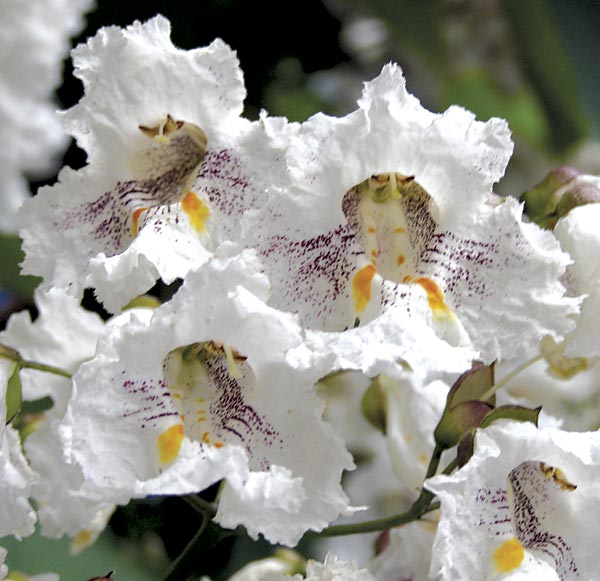The catalpa of blackberry winter
Originally published May 19, 2008

The tall flower-covered Northern Catalpa behind Weaver Street Market. Photo by Ken Moore
By Ken Moore
As usual, Mother’s Day and the university’s commencement have been accompanied by the typical cool stormy weather of “blackberry winter,†signaled by the flowering of wild blackberries along roadsides and woodland edges.
This past weekend’s blackberry winter weather was particularly stormy, as it delivered more needed rainfall, hopefully not the last before a harsh drought, as occurred last year.
In spite of the strong winds and rain, the tall Northern Catalpa, Catalpa speciosa, crammed in between Weaver Street Market and the Carr Mill main building remains covered with flowers. At the western end of the central walk of the UNC Coker Arboretum, there is another one. And the grandest specimen of all the Northern Catalpas is standing tall against the southeast corner of the Kenan Chemistry Tower across from the Coker Botany Building. You’ll have to examine the flower carpet on the ground beneath any of them to appreciate the beauty of the individual flowers.
In dramatic contrast, there is a huge spreading Southern Catalpa, Catalpa bignonioides, in a yard on the east side of Martin Luther King Blvd. near the intersection of Timberlyne. I remember that last year I was confused that the two trees flowered several weeks apart. I’m a bit wiser now. That big spreading one up near Timberlyne is the Southern Catalpa, which normally flowers several weeks after the northern species.
Catalpa, sometimes called Indian bean or cigar tree because of the long, slender bean pod-like capsules that hang on through the winter, is one of our most beautiful flowering trees. It appears that most of the specimens in and around Chapel Hill and Carrboro are the Northern Catalpa. There is a specimen of the Northern Catalpa with flowering branches at eye level, for easy close-up viewing, next to F & F Automotive Repair on Carrboro’s Weaver Street. Several smaller specimens are scattered throughout Carrboro, all exhibiting the taller, upright-habit, larger individual flowers and a pod a bit thicker than the smaller-flowered, shorter, wide-spreading Southern Catalpa. The heart-shaped leaves of both species usually occur in threes at the nodes along the stems.
Frequenters of Open Eye Café in Carrboro hopefully will encourage the management to make room for the little catalpa that has volunteered along the concrete pavement on the building’s south side. Perhaps they can get the town to break up the pavement a bit to allow it more freedom to grow.
Don’t miss taking a close look now while the Northern Catalpas are still in flower, and you’ll be in practice to catch the Southern Catalpas when they begin to flower in another week or two. In addition to the one up near Timberlyne, see if you can spot the Southern Catalpa along Weaver Street and the others in our community.
Now I’m wondering why the northern one flowers before the southern one.

Take a close look at these flowers of Northern Catalpa. Flowers of the later-blooming Southern Catalpa are a little smaller and just as beautiful. Photo by Ken Moore


Comments are closed.